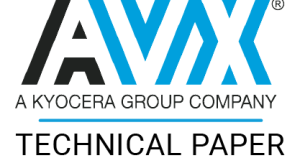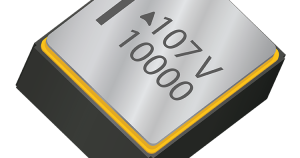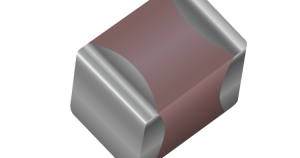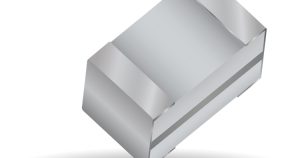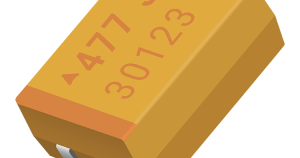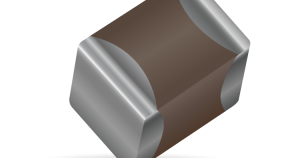Very High Frequency Switch Mode Power Supply Output Filter Capacitor Considerations and Mounting Limitations Written By: John Maxwell Abstract: This paper discusses output filter capacitor electrical limitations and considerations when used in 1MHz and above switch mode power supplies. Because surface mount components and assembly will be used to build these very high frequency switchers, physical mounting limitations, mechanical stress and assembly techniques are also discussed.
Technical Articles / Whitepapers
Advanced Test Methods for Up-screened Tantalum Capacitors Written By: Brian Brunette Abstract: Commercial-off-the-shelf capacitors are designed and tested for non-critical applications. AVX has developed a range of “COTS-Plus” tantalum capacitors with testing and reliability grading done in accordance with MIL-PRF-55365 and AVX proprietary methods to provide improved reliability on commercial ratings by removing weaker components within the populations. This paper will describe the criteria for selecting ratings appropriate for up-screening and describe the various tests that are standard and optional to demonstrate the improved reliability that results from these screening methods. Standard and “Space Level” options are described and compared to illustrate the scope of the COTS-Plus system.
Benefits of Thin-Film Dielectric Chip Capacitors at VHF, UHF, and Higher Frequencies Written By: Barry Breen | Leonid Talalaevsky | Scot Tripp Abstract: Present and future cellular networks and satellite telecommunications systems demand unique performance characteristics from the SMD capacitors incorporated into their designs. To meet these requirements, single layer surface mount capacitors have been developed on the basis of thin film technologies. The capacitor’s single layer thin film construction provides several major performance advantages relative to multilayer chips. These are much improved Q (low ESR), consistent and repeatable Q/ESR/Ceff/SRF parameters, superior power capability, no secondary resonances up to a frequency of 40GHz and very tight tolerance on capacitance value. By virtue of these characteristics and excellent mechanical features, this
Processing Guidelines for SMPS Multilayer Ceramic Capacitors Written By: John Maxwell | Mark Doty Abstract: Surface mount technology and high current layout techniques will be used as high frequency switch mode power supplies move to one megahertz and beyond. There are practical SMT size limitations to components without compliant leads due to solder joint failure but adding leadframes to larger parts does not degrade electrical performance while enhancing reliability.
Interconnect Schemes for Low Inductance Ceramic Capacitors Written By: Jeff Cain, Ph.D. Abstract: As digital electronic systems continue to operate at higher and higher frequencies, the use of low inductance decoupling capacitors continues to increase. The parasitic inductance of the devices themselves is important, but the method used to connect the components to the system, such as printed circuit boards (PCB), is also a considerable factor. Adding inductance in the connection scheme can eliminate some of the effectiveness of the use of these low inductance elements. This paper will examine some of the different schemes utilized at the board level to minimize the loop inductance of the decoupling capacitors.
Accu-P® Thin-Film Capacitors Act as Band Reject Filters Written By: Avital Yaish Abstract: AVX Accu-P® capacitors exhibit excellent resonance stability which makes them ideal for Band Reject Filters, whereas Ceramic capacitors are unsuitable due to their wide SRF scatter.
A Study of Field Crystallization in Tantalum Capacitors and its Effect on DCL and Reliability Written By: T.Zednicek | J. Sikula | H.Leibovitz Abstract: Tantalum has been the preferred capacitor technology for use in long lifetime electronic devices thanks to the stability of its electric parameters and high reliability. Failure rate performance measurements over time show a decreasing number of failures resulting in practically no wear out – unlike some other capacitor technologies. As in basically any material at temperatures above absolute zero there are processes that can lead to deterioration of the capacitor, there are also self-healing processes that are more effective that result in an overall failure rate reduction. Despite this phenomenon there are some known degradation mechanisms
A Review of High Frequency Passive Component Technologies (Thin-Film, Thick-Film, Discretes & PMC) for RF Design Applications Written By: Chris Reynolds Abstract: This article traces the evolution of these technologies and discusses the benefits and trade offs for each. The current level of RF component integration available in existing discrete package sizes is discussed, along with trends to tighter tolerance and ultra-stable parametric performance. The article concludes with an update on the emergence of higher levels of integration into passive component networks, and how this is now enabling engineers to optimize their RF designs. A version of this article was published in RF Design, August 2005.
Inductance Measurements for Multi-Terminal Devices Written By: Ben Smith Abstract: New innovations in both the telecommunication industry as well as the computer industry have mandated a need for using low inductance capacitive devices in power supply decoupling applications. With this being the case, different concepts for the construction of these devices have recently been the key to the success of reaching inductances of less than 50pH. There is, however, a significant bottleneck to the new innovation process due to measurement techniques. Most of the newer devices are using techniques such as multi-path current flow, short length, and equal and opposite current injection techniques to achieve low inductance levels. Also, coupled with these new designs is the need for higher energy
A Performance Comparison of Thin-Film and Wirewound Inductors Written By: Rom Demcko Abstract: This article evaluates the performance differences of thin-film and wirewound inductors. It looks at the properties of both technologies and evaluates the benefits particularly in wireless applications. A version of this article was previously published in Wireless Design and Development, May 2006.
Improved Noise Suppression via Multilayer Ceramic Capacitors (MLCs) in Power-Entry Decoupling Written By: Arch Martin | R. Kenneth Keenan Abstract: A new decoupling technique is proposed for surface mounted designs that recommends using 0.1 µF MLCs as the circuit-level decoupling capacitors and 1.0 µF to 10 µF MLCs in place of the tantalum as the board-level power-entry capacitor. This combination of MLCs on each PCB coupled with a single system level tantalum or aluminum is probably an optimum arrangement; performance is enhanced, and cost is not increased.
Functional Testing of Decoupling Capacitors For Dynamic RAMs Written By: Arch Martin | Ward Parkinson Abstract: Comparative performance of various types of distributed decoupling capacitors both with and without bulk tantalum capacitors is shown under actual operating conditions in a 64K dynamic RAM memory board designed especially for high-frequency in-use testing. Multilayer ceramic capacitors are shown to be effective and economical even without using bulk tantalum capacitors for decoupling.
Decoupling: Basics Written By: Arch Martin Abstract: This paper discusses the characteristics of multilayer ceramic capacitors in decoupling applications and compares their performance with other types of decoupling capacitors. A special high-frequency test circuit is described and the results obtained using various types of capacitors are shown.
BestCap®: A New Dimension in “Fast” SuperCapacitors Written By: Scot Tripp | Dr. Arieh Meitav Abstract: Supercapacitors or electrochemical caps are rapidly recognized as an excellent compromise between electronic capacitors such as ceramic, tantalum and aluminum electrolytic devices and batteries. Generally, supercapacitors have energy densities several orders of magnitude higher than electronic capacitors (Table 1) and power densities significantly superior to batteries. There are, however, two negative characteristics associated with existing electrochemical capacitors, high ESR and capacitance loss when called upon to supply very short duration pulses at high current. This paper will demonstrate how the BestCap® successfully addresses both of these issues.
BestCap®: A New Generation of Pulse Double Layer Capacitors Written By: Bharat Rawal | Lee Shinaberger Abstract: BestCap®, a new generation of Double Layer Capacitors (DLCs) have been developed to deliver low ESR, high power pulses, or provide back-up power in some applications. These capacitors have values of 10 to 560 mF, voltage ratings of 3.5 to 12 volts and ESR values of 20 to 500 mW. This paper describes the electrical properties of the BestCap® and it’s endurance under different environmental conditions. Specific applications are shown for illustrative purposes.
AC Termination For Signal Busses Written By: Ben Smith Abstract: The predominant direction of modern electronic system design is towards higher speed and efficiency. This is not to say that efficiency was not an issue in previous designs, but as clock speeds increase, many elements that once were treated as ideal cannot be treated in this manner any longer. Digital system designers are faced with critical issues dealing with maintaining signal integrity while balancing numerous other inhibiting factors. Perhaps one of the more menacing non-ideal effects can be seen in signal transmission through bus lines. Gone are the days when a trace of metal could be treated as a loss less element. Today’s high speed busses require a thorough evaluation
